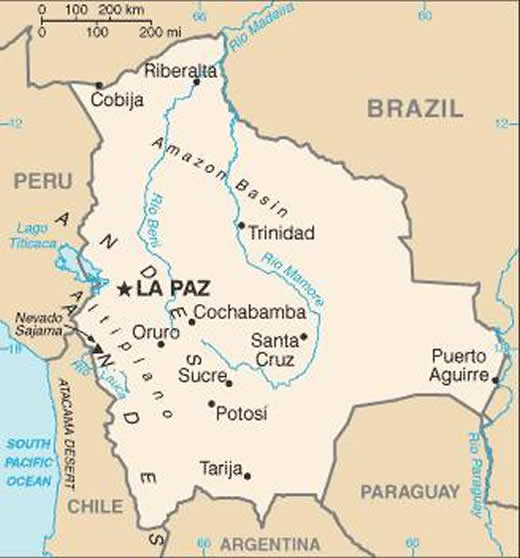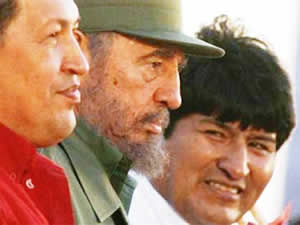Russia Bolivia to Launch Natural Gas Joint Venture
Commodities / Natural Gas Oct 14, 2009 - 11:26 AM GMT The latest news report that Russia will sign an agreement with the Bolivian government to explore and produce natural gas is a significant setback for US domination of its traditional Latin American sphere of influence. Since it was declared in 1823 as the Monroe Doctrine, the United States, especially its banking elites have regarded South America as a de facto ‘American plantation.’ The move by Russia’s state-owned Gazprom into Bolivia must be seen as Moscow’s asymmetric geopolitical response to US expansion of NATO to the doorstep of Moscow in recent years. The US is ill-prepared to counter with any economic incentive.
The latest news report that Russia will sign an agreement with the Bolivian government to explore and produce natural gas is a significant setback for US domination of its traditional Latin American sphere of influence. Since it was declared in 1823 as the Monroe Doctrine, the United States, especially its banking elites have regarded South America as a de facto ‘American plantation.’ The move by Russia’s state-owned Gazprom into Bolivia must be seen as Moscow’s asymmetric geopolitical response to US expansion of NATO to the doorstep of Moscow in recent years. The US is ill-prepared to counter with any economic incentive.
Gazprom Deputy CEO, Alexander Medvedev, announced at a recent energy conference in Argentina that they would sign a final agreement in the coming weeks with the Bolivian state oil and gas company, YFBP, for a major joint venture to develop Bolivia’s huge natural gas reserves. Bolivia has the second largest gas reserves (1.5 trillion cubic meters) in South America after Venezuela. Its key gas reserves are concentrated in the country's southeast in Santa Cruz.

The Russian gas deal follows talks with Moscow on increased Russian military aid to the Bolivian armed forces following a US cut-off of all aid.
 Bolivia’s President, Evo Morales, the country's first fully indigenous head of state in the 470 years since the Spanish Conquest, has been on the target list of Washington since his popular election in 2005. In September 2008 Morales expelled the US Ambassador, accusing him of fomenting opposition riots and protests against Morales. One week later, the Bush Administration responded by putting Bolivia on the “counter-narcotics” blacklist, cutting all US foreign aid. Curiously, the list is small, including only three countries, all firm opponents of US policies—Bolivia, Venezuela and Burma (Myanmar). Countries such as Mexico, Afghanistan, Colombia are not cited by Washington suggesting there might be another agenda there.
Bolivia’s President, Evo Morales, the country's first fully indigenous head of state in the 470 years since the Spanish Conquest, has been on the target list of Washington since his popular election in 2005. In September 2008 Morales expelled the US Ambassador, accusing him of fomenting opposition riots and protests against Morales. One week later, the Bush Administration responded by putting Bolivia on the “counter-narcotics” blacklist, cutting all US foreign aid. Curiously, the list is small, including only three countries, all firm opponents of US policies—Bolivia, Venezuela and Burma (Myanmar). Countries such as Mexico, Afghanistan, Colombia are not cited by Washington suggesting there might be another agenda there.
In January 2009 Morales again won a decisive national referendum allowing him to run for re-election and to take steps to control large landholdings. With a 60 per cent "Yes" vote, Morales can seek re-election in December 2009. As well, under the new powers, rich landowners may be targeted for dispossession as the state now only allows private ownership of large estates, Latifundistas, if the land is put to ‘social use.’ If not, the land may be seized by the state and redistributed. As well the referendum gave the state more power over its energy resources.
War over water and energy
The US interest in Bolivia is little other than crass exploitation of that country’s huge resources. Washington sent Harvard “shock therapy” economist Jeffrey Sachs to Bolivia in the 1980’s to impose his radical therapy which killed inflation and did nothing to alleviate the severe poverty. It did open up the resources of the country to cheap exploitation by foreign multinationals like BP and ExxonMobil as well as British and American water companies.
Former Vice President Dick Cheney’s old firm Halliburton had plans to exploit Bolivia’s natural gas for export. In 2002 popular outrage over the generous terms given by an earlier pro-US government to Halliburton led to nationwide protests, dubbed the “Bolivian Gas War” by media.
With growing popular protests and national strikes against foreign exploitation of the country’s resources, the Bolivian Congress passed a new Hydrocarbons Law in 2005 that partially re-nationalized the energy resources, while allowing foreign companies to lease, albeit on less generous terms. YPFB had been privatized in 1996 and British firms BP and BG along with Halliburton and ExxonMobil immediately came in then to build a multi-billion dollar gas pipeline to export LNG to California. Cheney’s Halliburton was the main construction contractor.
Morales won a landslide election victory in December 2005 on a pledge to use the country’s resources to develop the country’s economy, one of the poorest in South America. Since that time Washington has covertly been supporting various opposition groups in Santa Cruz province in the region of the gas and huge fresh water resources.
On May 1, 2006, President Morales signed a decree stating that all gas reserves were to be nationalized: "the state recovers ownership, possession and total and absolute control" of hydrocarbons. Since then the government's energy-related revenue doubled and has increased six-fold from 2002. Foreign companies were either compensated for their holdings as with Shell, or continued to work but as minority partners with the state.
Bush finds a ‘retirement’ ranch
Shortly before leaving office, according to South American media reports, then President George W. Bush drew considerable attention in Bolivia with reports he had arranged to buy a huge tract of land on the Triple Frontier border of Paraguay, Brazil and Bolivia “to retire.” Bush reportedly bought some 40000 hectares of land in Chaco, Paraguay, near a US military base. Significantly, the land is reportedly located in Paso de Patria, near Bolivian gas reserves and the Guarani indigenous water region, within the Triple Border. The Guarani Aquifer is one of the largest underground water reserves in South America, running beneath Argentina, Brazil, Paraguay and Uruguay, and larger than Texas and California together.
South America is now all but lost to US influence, with only Colombia, a stalwart ally, and Peru considered still in Washington’s geopolitical orbit. The rest of the region has now swung against US influence, led by Hugo Chavez of Venezuela, who has cultivated anti-US allies like Iran and Cuba, and has now invited the Russian air force and navy to exercise in the Caribbean. Bolivia’s Morales has strong ties to the governments of Venezuela, Ecuador and recently of Paraguay, where former Bishop Fernando Lugo won an upset victory in April 2008 breaking the 61 year domination of the right-wing military Colorado Party.
The Bolivia-Russia Gazprom deal further secures a degree of economic independence for Bolivia from the historical US economic domination. For Russia, it offers an excellent chance to up pressure on the United States in its backyard, its traditional “sphere of influence” in the Americas, long considered a Rockefeller family plantation. Given its deepening domestic economic crisis, the Obama Administration has few cards to play beyond trying to create chaos in the region. It has little positive to offer Bolivia or any of its neighbors. The process is like a ‘Grade B’ rerun of the collapse of the British Empire in Africa and the Indian Subcontinent after the Second World War.
By F. William Engdahl
www.engdahl.oilgeopolitics.net
*F. William Engdahl, author of Full Spectrum Dominance: Totalitarian Democracy in the New World Order (Third Millennium Press), may be reached via his website, www.engdahl.oilgeopolitics.net.
COPYRIGHT © 2009 F. William Engdahl. ALL RIGHTS RESERVED
F. William Engdahl Archive |
© 2005-2022 http://www.MarketOracle.co.uk - The Market Oracle is a FREE Daily Financial Markets Analysis & Forecasting online publication.



